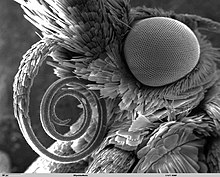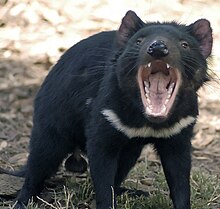Mouth
| Mouth | |
|---|---|
Basel Zoo in Switzerland | |
| Details | |
| Identifiers | |
| Latin | os, oris[1] |
| MeSH | D009055 |
| TA98 | A05.1.00.001 |
| TA2 | 119, 2774 |
| FMA | 49184 |
| Anatomical terminology] | |
The mouth is the
instead of oral teeth.Most
Development

In the first
However,
In animals at least as complex as an
Anatomy
Invertebrates

Apart from sponges and
Vertebrates
In vertebrates, the first part of the digestive system is the
Nearly all amphibians are carnivorous as adults. Many catch their prey by flicking out an elongated tongue with a sticky tip and drawing it back into the mouth, where they hold the prey with their jaws. They then swallow their food whole without much chewing.
The mouths of reptiles are largely similar to those of mammals. The
Birds do not have teeth, relying instead on other means of gripping and macerating their food. Their beaks have a range of sizes and shapes according to their diet and are composed of elongated mandibles. The upper mandible may have a nasofrontal hinge allowing the beak to open wider than would otherwise be possible. The exterior surface of beaks is composed of a thin, horny sheath of keratin.[20] Nectar feeders such as hummingbirds have specially adapted brushy tongues for sucking up nectar from flowers.[21]
In mammals, the buccal cavity is typically roofed by the
Other functions of the mouth
Crocodilians living in the tropics can gape with their mouths to provide cooling by evaporation from the mouth lining.[23] Some mammals rely on panting for thermoregulation as it increases evaporation of water across the moist surfaces of the lungs, the tongue and mouth. Birds also avoid overheating by gular fluttering, flapping the wings near the gular (throat) skin, similar to panting in mammals.[24]

Various animals use their mouths in threat displays. They may gape widely, exhibit their teeth prominently, or flash the startling colours of the mouth lining. This display allows each potential combatant an opportunity to assess the weapons of their opponent and lessens the likelihood of actual combat being necessary.[25]
A number of species of bird use a gaping, open beak in their fear and threat displays. Some augment the display by hissing or breathing heavily, while others clap their beaks.[26]
Mouths are also used as part of the mechanism for producing sounds for communication. To produce sounds, air is forced from the lungs over
See also
References
- ISBN 978-3-03019-898-5. Retrieved December 24, 2023.
- ^ Gray, Henry (1918). "2a. The Mouth". Gray's Anatomy. Archived from the original on Oct 10, 2022.
- ^ "Buccal definition". Dictionary Reference. The Free Dictionary. Retrieved 18 July 2013.
- ^ "Mouth definition". Dictionary Reference. The Free Dictionary. Archived from the original on Sep 30, 2013. Retrieved 18 July 2013.
- ^ ISBN 978-0-03-030504-7.
- S2CID 4406268.
- ISBN 978-81-315-0104-7.)
{{cite book}}: CS1 maint: multiple names: authors list (link - ISBN 978-81-315-0104-7.)
{{cite book}}: CS1 maint: multiple names: authors list (link - ISBN 978-81-315-0104-7.)
{{cite book}}: CS1 maint: multiple names: authors list (link - ISBN 978-81-315-0104-7.)
{{cite book}}: CS1 maint: multiple names: authors list (link - ISBN 978-81-315-0104-7.)
{{cite book}}: CS1 maint: multiple names: authors list (link - ISBN 978-81-315-0104-7.)
{{cite book}}: CS1 maint: multiple names: authors list (link - ISBN 978-0-03-030504-7.
- ISBN 978-0-03-030504-7.
- ISBN 978-0-691-03281-8.
- PMID 24023957.
- ^ Nuwer, Rachel (13 May 2013). "Solving an alligator mystery may help humans regrow lost teeth". Smithsonian.com. Archived from the original on Jun 12, 2013. Retrieved 4 November 2013.
- ISBN 0412461102.
- ISBN 0-394-50824-6.
- ISBN 0-7167-2415-4.
- .
- ^ Pourtauborde, Aniza. "What is the buccal cavity?". WiseGeek. Conjecture Corporation. Retrieved 2013-11-30.
- ISBN 978-1-85391-092-0.
- PMID 16675613.
- ^ "Showing Off Your Weapons In The Animal Kingdom: Threat Displays May Prevent Serious Physical Harm". ScienceDaily. 2006-06-21. Retrieved 2013-11-30.
- ISBN 0-674-00827-8.
- ^ "The production of speech sounds: Articulators above the larynx". personal.rdg.ac.uk. Retrieved 2013-11-30.
- ISBN 978-0-691-03281-8.
- ^ Ehrlich, Paul R.; Dobkin, David S.; Wheye, Darryl (1998). "Bird voices". web.stanford.edu. Retrieved 2013-11-30.
